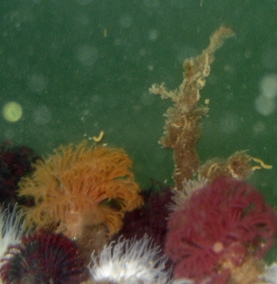Schizobranchia insignis
From ize
 Schizobranchia insignis, here pink and orange
Schizobranchia insignis, here pink and orange
| Taxonomy | |
|---|---|
| Kingdom: Animalia | |
| Phylum: Annelida | |
| Class: Polychaeta | |
| Order: Sabellida | |
| Family: Sabellidae | |
| Genus: Schizobranchia | |
| Species: S. insignis Bush 1905 |
Contents |
Common Names
Split-Branch Feather Duster, Split-Plume Feather Duster, Feather Duster Worm
Description
Tube is 10-20 cm long, 5-10 mm in diameter, whitish and pliable. Color of tentacular crown is uniform orange, red, mauve, tan, brown, grey, or green.
Geographic Distribution
Alaska to Central California.
Habitat
Commonly found living attached to pilings and rocks, intertidal to 46 m. Abundant on the underside of wharves in Puget Sound. Can be found on wharves at Boston Harbor marina.
Life History
Schizobranchia insignis is free-spawning, releasing gametes into the water column for fertilization.[1] If disturbed by touch, water movement, or shadow, the tentacular crown can be quickly withdrawn entirely within the tube, by retractor muscles. Ciliated radioles (feathery tentacles) collect planktonic particles, which are trapped in mucus and carried to the mouth.
Physiology and Biochemistry
Schizobranchia insignis has been found to accumulate dissolved carbon exuded by an alga.[2] For feeding and respiration, S. insignis reportedly passes 70 ml/hr/g animal (fresh weight) of water through the tentacular crown by the cilia's movement.[3] The hooked setae of Schizobranchia insignis have been found to dig into the tube wall and serve as anchors, likely to secure the worm from being sucked out by a fish or pulled by wave action. Worms were found to withstand high pressures of 100-200 kPa (applied experimentally, from posterior).[4]
Ecosystem Role
Along with other species of polychaete worms, S. insignis is host to kleptoparasitic suspension-feeding snails, like Trichotropis cancellata, that live on the worms and steal food.[5]
Identification
Among Pacific Northwest sabellids, S. insignis is unique in that all radioles are dichotomously branched at least once. Radioles of Eudistylia polymorpha are not branched, and only a few of the radioles of E. vancouveri are branched.
Footnotes
- ↑ Thomas, F., 1998. Transport and mixing of gametes in three free-spawning polychaete annelids, Phragmatopoma californica (Fewkes), Sabellaria cementarium (Moore), and Schizobranchia insignis (Bush). Journal of Experimental Marine Biology and Ecology. 179, 1: 11-27.
- ↑ Fankboner, P.V. & L.D. Druehl, 1976. In situ accumulation of marine algal exudate by a polychaete worm (Schizobranchia insignis). Cellular and Molecular Life Sciences. 32, 11: 1391-1392.
- ↑ Phillips Dales, R., 1961. Observations on the respiration of the sabellid polycheate Schizobranchia insignis. Biological Bulletin. 121: 82-91.
- ↑ Merz, R.A. & S.A. Woodin, 2000. Hooked setae: tests of the anchor hypothesis. Invertebrate Biology. 119, 1: 67-82.
- ↑ Iyengar, E.V., 2004. Host-specific performance and host use in the kleptoparasitic marine snail Trichotropis cancellata. Oecologia. 138, 4: 628-639.
External Links
- photo of S. insignis (Intertidal Marine Invertebrates of the South Puget Sound)
- photo of S. insignis (California Academy of Sciences)
References and More Information
Brusca, R.C. & G.J. Brusca, 2003. Invertebrates. Sinauer Associates, Inc, Sunderland, Massachusetts.
Kozloff, E. N., 1996. Marine Invertebrates of the Pacific Northwest. University of Washington Press, Seattle, Washington.
Kozloff, E. N., 2000. Seashore Life of the Northen Pacific Coast. University of Washington Press, Seattle, Washington.
Lamb, A. & Hanby, B.P., 2005. Marine Life of the Pacific Northwest: a photographic encyclopedia. Harbour Publishing, British Columbia.
